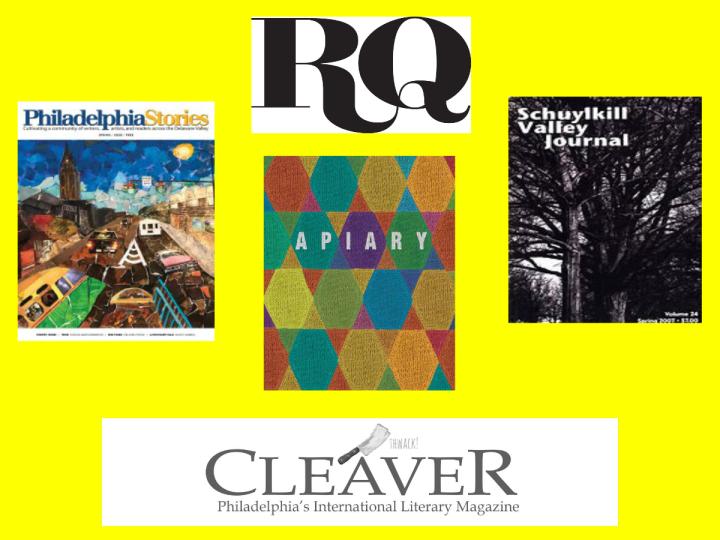By Sanjana Ramanathan
With stay-at-home orders in place all over the nation and quarantine boredom settling in, many people are searching for new material to occupy the time. There is an often-overlooked source of content that provides writing and art online, and often for free: literary magazines. The writers’ community in Philadelphia and surrounding areas has long been fostered by literary magazines. These journals provide an important platform for both emerging and well-known creators, publishing poetry, essays, short stories, and prose; some also feature art, photography, articles, and reviews.
One such magazine is Apiary, a publication whose goals are to “celebrate Philadelphia as a great literary city on the page, stage, and in the street” and “connect and inspire Philadelphians through the power of their own words,” according to their website. Founded over a decade ago, Apiary’s volunteer staff is dedicated to providing a platform for the city’s literary community. Their issues are published both in print and online, and all previous issues are available for free viewing in an archive on their website.
Apiary’s tenth and most recent issue, published in December of 2019, is a culmination of the magazine’s history and current success. The works included in this issue are in “conversation” with writers in previous issues, and the pages also feature intergenerational interviews from Philly’s literary heroes. The issue is truly a celebration of the city’s writing community, with over a hundred pages of wonderful prose, poetry, and art.
Philadelphia Stories is a nonprofit organization that has been serving the Greater Philadelphia area since 2004. Its mission is to “to cultivate a community of writers, artists, and readers” through affordable programs, including annual contests, professional development workshops, and their free print magazines. Philadelphia Stories offers many opportunities for writers, including conferences, workshops, and writer’s retreats. Although the pandemic may put many of these in-person events on hold, their magazines and contests are currently accepting online submissions.
The organization publishes three magazines: Philadelphia Stories Magazine (for local contributors over 18); PS Teen (ages 13-18); and PS Junior (ages 12 and under). All issues are available for download online. Their most recent issue features the winning poem of their annual Sandy Crimmins Poetry Contest, honoring the memory of a former board member by celebrating “risk and innovation in poetry.” Winner Kari Ann Ebert’s poem “Milk Sickness: A Mother Worries as Her Children Sleep” certainly embodies this, uniquely capturing the feeling of parental fear with an “an expert command of sound and image.”
Founded in 1990, Schuylkill Valley Journal continues today to publish poetry, fiction, creative nonfiction, flash fiction, and personal essays. Poet Peter Krok (nicknamed “the red brick poet” because of his association with Philadelphia row houses) has been Editor-in-Chief of the journal since 2001, keeping its established goal of showcasing “fresh voices.” Although their biannual print magazine is published in spring and fall, their online issues are posted every two months.
The SVJ website’s archive also features art, stories, and interviews. A notable feature of their website is their “Poetry Lit Picks” posts, in which the managing editor collects “highlights and recommendations from recent issues of [other] literary journals.” Scrolling through the short snippets of pieces is a great way to discover new works, writers, and magazines.
Root Quarterly is a Philadelphia-based journal that aims to challenge and inspire its readers. Although the magazine is print-only, Root Quarterly accepts email submissions of personal essays, articles, art, photography, cultural thinkpieces, recommendations, and long-form profiles of Philadelphia region artists. The magazine was recently honored as a 2019 Best New Magazine by Library Journal, where writer Peter Koonz remarked that the issues are “a joy to leaf through—and read.”
Root Quarterly seeks to be more than just a journal, aiming to cultivate a community that challenges beliefs and opens new conversations. Each issue also features a creative theme tying together all selected pieces within. Their most recent issue, published during the pandemic, takes advantage of its flowery “Buds” theme to bring new fresh content in the bleakness of an “interrupted” spring. Although Root Quarterly only features previews of each issue for free online, full issues can be viewed by individual purchase or an annual subscription to the magazine.
Aiming to support both emerging and established writers, Cleaver is a Philly-based quarterly magazine that offers free access to their issues on its website. As the name suggests, the magazine offers “fresh-cut lit” in the form of fiction, flash fiction, poetry, essays, and reviews. In their submissions, Cleaver looks for works that “represent the fullest diversity of literary art for all genres and content.”
True to their goal, the latest issue features a variety of new content. Cleaver also aims to celebrate the works “emerging writers and artists alongside established practitioners.” They make sure to do so in each issue, highlighting emerging artists with a symbol next to their name and work title. These up-and-comers are listed on a designated page on their site, providing a platform for new artists in all previous issues. Cleaver’s website also offers workshops, internship opportunities, interviews, and an entertaining advice column.
Although the pandemic prevents Philly’s writing community from interacting through in-person events, literary magazines provide an important platform for sharing and discovering work. Most magazines already have established websites and publish their issues online, allowing for at-home access even during quarantine. Nearly every website linked above has a donations page, which you can use to support the staff—often entirely volunteers—of these magazines. Though the global crisis continues to affect daily life, literary magazines work to keep art flourishing and the writing community connected.

Sanjana is a second-year undergraduate student at Drexel University pursuing a degree in English with a concentration in Writing. She enjoys playing video games, cracking open a new book, and daydreaming. She writes poetry, short fiction, articles, and essays.
